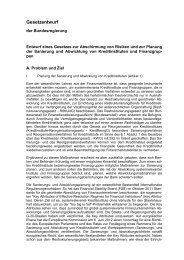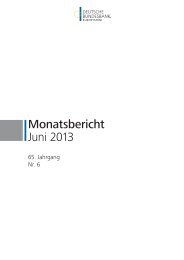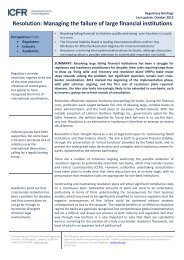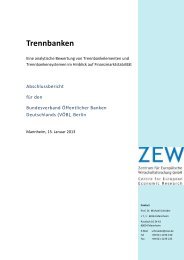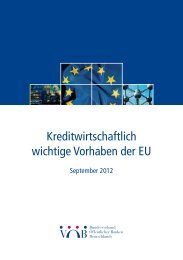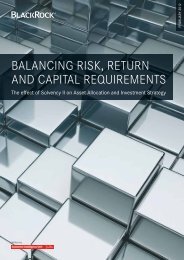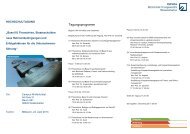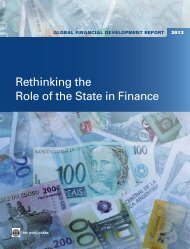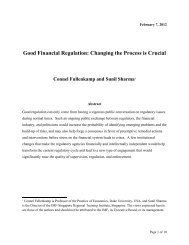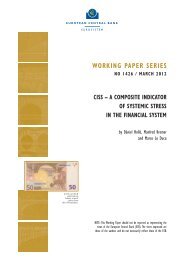3 Issuing costs of state guaranteed bonds - Financial Risk and ...
3 Issuing costs of state guaranteed bonds - Financial Risk and ...
3 Issuing costs of state guaranteed bonds - Financial Risk and ...
Create successful ePaper yourself
Turn your PDF publications into a flip-book with our unique Google optimized e-Paper software.
3 <strong>Issuing</strong> <strong>costs</strong> <strong>of</strong> <strong>state</strong> <strong>guaranteed</strong> <strong>bonds</strong><br />
external finance. Empirically, these differences can be observed <strong>and</strong> indicate whether credit<br />
constrained banks had selected into guarantee schemes or not.<br />
Anecdotally, the general perception is that limited activity on wholesale funding markets reflected<br />
banks' inability to access wholesale funding at all. If this is really the case, banks were not,<br />
therefore, substituting SG <strong>bonds</strong> for non-SG <strong>bonds</strong> they could have been issuing.<br />
Further, Acharaya <strong>and</strong> Sundaram (2009) show that guarantee fees represented a small tax rather<br />
than a subsidy to banks taking up SG <strong>bonds</strong>. This further supports the notion that banks did not<br />
have an incentive to take-up SG <strong>bonds</strong> if alternative wholesale funding options were available to<br />
them.<br />
To summarise, empirically assessing the effectiveness <strong>of</strong> <strong>state</strong> guarantees in restoring the proper<br />
functioning <strong>of</strong> wholesale funding markets (<strong>and</strong> related policy questions) requires an underst<strong>and</strong>ing<br />
<strong>of</strong> how <strong>state</strong> guarantees influenced choices made by investors to supply funds <strong>and</strong> choices made<br />
by banks to dem<strong>and</strong> funds. Investor decision-making is driven by returns to SG <strong>and</strong> non-SG <strong>bonds</strong><br />
only, hence these are considered in isolation <strong>of</strong> fees banks face. Bank decision-making is driven by<br />
returns (or issuing <strong>costs</strong>) <strong>and</strong> fees. However, these cannot be analysed because data on issuing<br />
<strong>costs</strong> in the absence <strong>of</strong> <strong>state</strong> guarantee schemes is unavailable.<br />
Credit spreads<br />
<strong>Issuing</strong> cost is generally expressed as the difference between the returns or yield investors can<br />
expect from a given SG/non-SG bond <strong>and</strong> a comparable benchmark security/curve that is<br />
(assumed) risk free. This difference captures the additional return investors must be paid in order<br />
to compensate them for assuming the additional credit risk embedded within an SG/non-SG bond<br />
<strong>and</strong> is known as the credit spread.<br />
From a policy perspective, credit spreads provide a highly valuable measure <strong>of</strong> issuing cost. This is<br />
because they also summarise market perceptions <strong>of</strong> the credit risk <strong>of</strong> banks, which is fundamental<br />
to underst<strong>and</strong>ing the role <strong>state</strong> guarantees played in stimulating activity on wholesale funding<br />
markets.<br />
Practically, credit spreads allow for the relative value <strong>of</strong> SG <strong>and</strong> non-SG <strong>bonds</strong> to be compared<br />
within <strong>and</strong> across banks through a single statistic.<br />
The spread to Treasury at issue, for instance, on the $1bn SG bond issued by Barclays Bank in<br />
March 2009, for instance, was 149bps (or 1.49%), implying that investors as a group required an<br />
additional $14,900,000 per annum compared to what they would require in order to invest in a<br />
comparable Treasury security on the day <strong>of</strong> issue. Meanwhile, the spread to Treasury at issue on<br />
the $1bn SG bond issued by Swedbank was 119.3bps, implying that the difference in credit risk<br />
between the two SG <strong>bonds</strong> amounted to 29.7bps (149bps – 119.3bps) or $2,970,000 per annum.<br />
Further, credit spreads summarise a range <strong>of</strong> factors that influence credit risk, which can be<br />
isolated empirically to consider policy questions such as the impact <strong>of</strong> <strong>state</strong> guarantees on issuing<br />
cost. Continuing with the examples <strong>of</strong> the Barclays Bank <strong>and</strong> Swedbank bond issues described<br />
above, several comments regarding the sources <strong>of</strong> differences in credit risk can be made. For<br />
example, firstly, the Swedbank SG bond was issued in Jun 2009 when wholesale funding markets<br />
were, at least to some degree, different to March 2009. Secondly, the maximum tenor was four<br />
31



